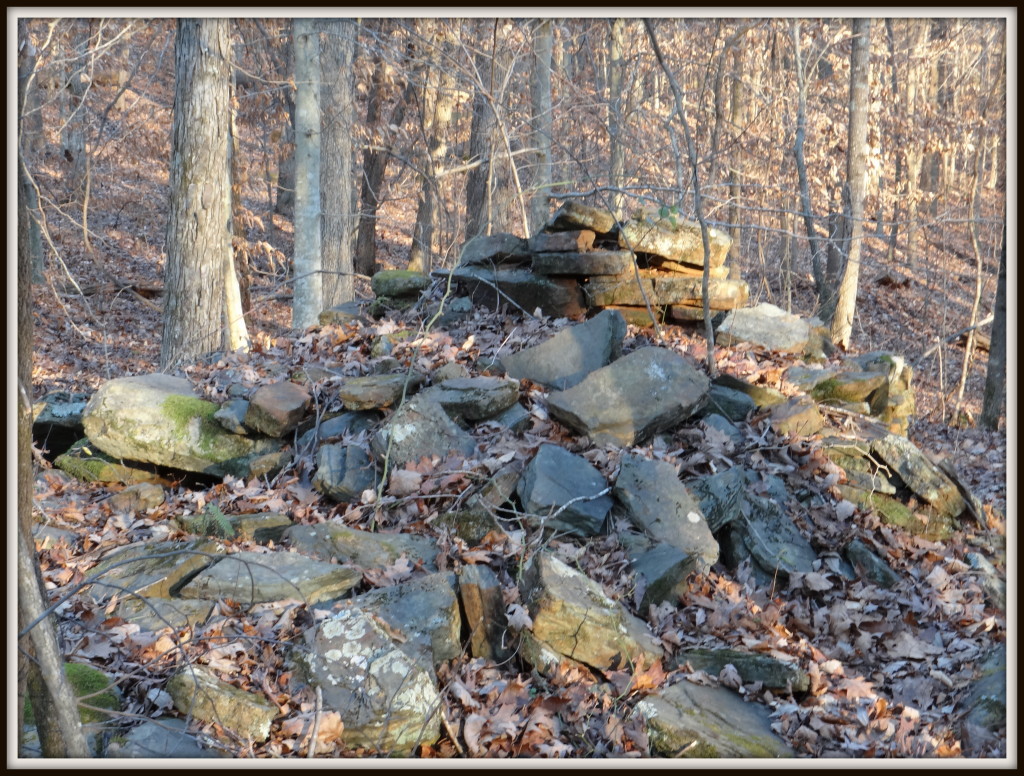Returning home from my visit to Little Mulberry Park in Gwinnett County, I set to work finding out what I could online about the origin and purpose of the mysterious stone piles I had seen. Were they “almost certainly associated with native american cultures” as the information sign in the park indicated? If so, how old were they, and what evidence has been found linking them to prehistory? The more research I did, the more convinced I became that “almost certainly” is, almost certainly, not an accurate phrase to use. Indeed, the Little Mulberry Park Master Plan drafted in 2001 did not offer a definitive explanation for the piles, instead noting that “the stacked stone mounds have been variously attributed to pre-Columbian habitation by Native Americans and to post-settlement agriculture….” Based upon this uncertainty, the master plan added, “it is intended that appropriate interpretive signage will be placed to present the various theories about the mounds” [emphasis added]. Various theories? What do we truly know about these stone piles, and what is conjecture? Where is the evidence?
Clearly, I thought, there must be some fairly strong evidence leading archaeologists to conclude that the mounds are prehistoric. In 1989, the site (officially termed the Parks-Strickland Archaeological Complex) was added to the National Register of Historic Places, where it is listed as a prehistoric site dating from between 499 BC and 499 AD. According to the National Recreation Trails website (hosted by AmericanTrails.org), the site’s “pre-historic stone mounds” date to the Middle Woodland period of Native American prehistory, between 100 BC and 500 AD. Furthermore, “Portions of the stone mounds appear to be patterned to represent a stylized serpent figure which demonstrates careful and consistent techniques of early construction.” It should be noted that this was the only source I could find that claimed some pattern or structure to any of the mounds, beyond observations that many of the mounds show signs of rock stacking and some are roughly cylindrical in shape.
What evidence is there for ascribing a Late Woodland age to the stone structures, and what do archaeologists think they were intended to be? It turns out that the mounds were first investigated by Atlanta archaeologist Patrick Garrow, and he is responsible both for raising awareness of the potential cultural significance of the stone piles, and for proposing and strongly advocating that they are pre-settlement in origin. According to a May 1990 article in the Free-Lance Star, a Fredericksburg, Virginia newspaper, Garrow found over 200 rock mounds, and is quoted in the article as speculating that “I think it was a complex for burial of the dead and a ceremonial complex.” “But,” he added, “I’m guessing here. No one is absolutely sure.” In fact, no Woodland period (or prehistoric in general, for that matter) artifacts were found in or near any of the stone piles, nor were any human remains encountered.
In a 1988 archaeological investigation report by Patrick Garrow and David Chase of Garrow Associates, Inc. (discussed here), the authors gave several arguments as to why the stone piles are likely prehistoric. While some of the mounds are situated parallel to previous boundary lines, others are not. If the piles were formed by farmers removing rocks from a field, wouldn’t they collect the stones along a property line, to keep “wasted” land to a minimum? Also, why would area farmers bother to pile rocks in the first place, since the area was used as pasture and never actually plowed? Why would farmers clearing a field bother to stack the rocks with so much care? Finally, the rock piles are not random; many are located at equal distances from each other. Wouldn’t rock piles formed by farmers clearing their fields be more randomly situated? (Random, that is, if one overlooks the first idea, that the piles should be preferentially parallel to boundary lines.) All of these arguments are based upon the rejection of one alternative explanation for the stone piles: namely, that they could have been the work of post-settlement farmers clearing their land of rocks. By arguing against this scenario, Garrow and Chase somehow managed to conclude that the piles have to be prehistoric because there is no other reasonable explanation for their origin. In short, there is not one single piece of evidence that the stone piles at Little Mulberry Park are actually prehistoric. As we shall see in the final installment of this series, however, there is considerable evidence pointing to a different story behind the stone piles.
